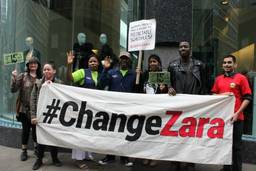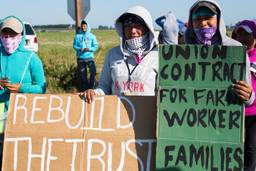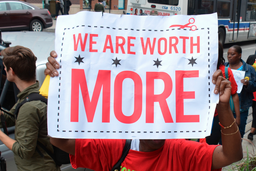
This article was first posted by Labor Notes.
As the reality of a Donald Trump presidency sets in, unions and workers centers are gearing up for a massive fight to defend immigrant members, building on lessons from the past decade.
Undocumented workers are at risk both from the government and from their employers. Sometimes employers are under government pressure themselves. Other times they’re using the threat of immigration enforcement to discourage organizing or keep workplace standards low.
Besides workplace or home raids, over the past decade workers have faced:
- I-9 audits, where Immigration and Customs Enforcement investigates employers to ensure workers have the right documentation to work legally
- No-match letters, where the Social Security Administration notifies employers that the name or social security number on a worker’s W-2 form doesn’t match its records
- E-Verify, an online system that checks workers’ eligibility to work, mandatory in some states and voluntary in others
The president-elect campaigned on promises to deport millions of undocumented workers and to target immigrants from Muslim countries. While we don’t yet know Trump’s game plan for attacking immigrant workers, here’s a checklist of five questions to ask as your union or worker center prepares to defend members:
1. What resources can you share with members?
Although laws may change, one concrete step you can take right now is to organize “Know Your Rights” trainings and share resources.
For instance, everyone has the right to remain silent if they encounter immigration officials.
“Many workers here are very worried about what’s going to happen to them under the Trump administration,” says Rigoberto Valdez, director of organizing at UFCW Local 770 in Los Angeles.
Local 770 is working with L.A. immigrant advocacy groups to develop new materials to help inform members of their legal rights. (Click here for a list of existing resources, including a bilingual video in English and Spanish.)
It’s important for members to know that they should never share information about their immigration status with their employer or law enforcement, and that they should always carry with them the phone numbers of their union and local legal services.
Groups should make clear that if workers are seeking a union and have already filed with the National Labor Relations Board — either over unfair labor practices or for a certification election — the Department of Homeland Security has agreed to not engage in workplace enforcement.
The same applies to workers enforcing their rights under the Occupational Safety and Health Administration for health and safety issues at work, or under the Department of Labor for wage and hour protections.
2. How’s your contract language?
Does your union have contract negotiations coming up? Start talking about how you can use bargaining to strengthen workplace protection for immigrant members.
UNITE HERE Local 2850 in the Bay Area has won language that allows workers to take leaves of absence — and protects their seniority — if they need time to complete immigration paperwork. It bars employers from penalizing workers who change their names or social security numbers.
The contracts also limit how employers cooperate with Immigration and Customs Enforcement, “so they don’t go over and above what is required [by law],” says President Wei-Ling Huber. And the local has negotiated a legal fund that employers pay into, which members can draw on for immigration-related cases.
Look at model contract language on work authorization and reverification, Social Security no-match letters, changes in social security numbers, participation in E-Verify programs, and notification of ICE raids and detentions. Download the Service Employees (SEIU) version at labornotes.org/immigration.
3. If your members don’t have union contracts, what other tactics can you use to push employers?
There are better and worse ways for employers to respond to audits and raids. You don’t need a contract to negotiate with employers over this — and the first step is knowing what their obligations and choices are.
The Restaurant Opportunities Center-United and the National Employment Law Project are preparing fact sheets on what employers should and shouldn’t do.
For example, “if an employer gets notice of an E-Verify check or an ICE notice — they need to share that info with workers in a responsible way,” says Teófilo Reyes, national research director at ROC-United. “It can’t be a tool to get people to quit and leave.”
“You have to be able to give the employer some legal cover, so they are able to do the minimum required under law,” says Mark Meinster of Warehouse Workers for Justice.
His group worked with other Chicago-area unions and worker centers to form the Dignity Project in 2007. The coalition responded to a slew of no-match letters sent by the Social Security Administration, mainly in non-union workplaces.
The coalition set up a hotline that workers could call, trained worker advocates and unions on how to deal with employer threats, and supported organizing in workplaces where mass firings were looming because of the letters. It saved about 500 jobs.
One lesson, Meinster said, was that on-the-job action was key. In one example, the boss at a soap factory received multiple no-match letters, putting workers’ jobs at risk. “A whole bunch of people walked out and were able to win that strike and force the company to rehire everybody,” Meinster said.
“The group has to take action together,” he says, “and that means doing a lot of work on the front end to unite people who might not be immigrants or undocumented. It’s best if you can take the position that either all of us work, or none of us work.”
4. Can you join a rapid-response network or a community coalition?
For unions that don’t have many immigrant members, joining an existing network is a concrete way to support immigrant workers in your community. Do you know what groups are organizing around immigration in your community? Can you build relationships and support their work?
For those that do, when leaders are detained or facing deportation, unions and worker centers may have to respond quickly. What alliances could your union start building now, so that you are ready if you need to defend targeted members?
A citywide rapid-response network supported the workplace actions in Chicago by turning out supporters for pickets and direct actions. In other communities, such networks can provide expert support in case of workplace or community raids. The National Immigration Law Center has tips on how to develop a rapid-response team by recruiting community leaders and immigration attorneys in advance of potential raids.
The worker center Desis Rising Up and Moving launched a local Hate Free Zone. A thousand people marched through the streets of Jackson Heights, Queens, December 2, to show their support.
“The message was ‘we want to make sure our community is safe, and people know it’s safe and are actively going to be protecting each other,” says Basma Eid, an organizer with the national worker center alliance Enlace.
Pittsburgh’s chapter of the Labor Coalition for Latin American Advancement has been leading a fight to free a local labor leader, Martin Esquivel-Hernandez, detained in a for-profit prison on immigration charges. A hundred community allies marched on November 15 to demand his release. Migrant Justice in Vermont has also mobilized community support to free several farmworker leaders who were held in detention.
5. Can you make your city or workplace a sanctuary?
Hundreds of counties and dozens of cities across the U.S. have passed policies limiting cooperation with federal immigration enforcement. Most include “Don’t Ask, Don’t Tell” policies where cities commit not to ask residents about their immigration status, and not to share that information with ICE.
“We know that a sanctuary city policy is not going to [completely] resolve the problem,” says Rosanna Aran of the Laundry Workers Center, one of the groups working to get such ordinances passed in Orange and East Orange, New Jersey. “But we are trying to create a safe space for the community, a zone free of intimidation and retaliation.”
Passing such policies and defending them — Trump has threatened to cut off federal funds to sanctuary cities — are fights that unions can take on, says Andrea Mercado, campaign director of the National Domestic Workers Alliance.
“Labor unions often have a lot of political leverage with political leaders that a lot of times immigrant organizations don’t have,” she says. “Institutions that have those kinds of relationships and access can push elected leaders to step up.”
At school boards, teachers have used their leverage to get sanctuary policies passed, declaring schools to be safe zones.
United Teachers Los Angeles is part of a coalition pushing to strengthen Los Angeles’s role as a sanctuary city. UTLA has already worked with the school district to ensure that teachers and other school district staff do not track students’ immigration status, and that ICE officers cannot enter schools without permission from the superintendent.
UTLA held a “Know Your Rights as Educators” forum in December, where teachers got information on Deferred Action for Childhood Arrivals, Obama’s initiative for undocumented residents who came to the United States as children. Union leaders facilitated discussions of what concerns teachers were hearing from students and how the union could help build community networks to defend immigrant families.
An emerging sanctuary campus movement is calling on colleges and universities to declare their campuses as safe places for all students and campus workers, regardless of immigration status. In December, Northeastern University students and workers organized a delegation asking the university to declare the college a sanctuary and sign onto a set of principles written by dining hall workers.
The fight ahead
We’re living in daunting times, but all of us can start somewhere. The Laundry Workers Center is starting, Aran says, by reaching out to workers with a message of courage. “We are explaining that they are not alone and we’re going to fight together and united.”
“There are going to be polices that make us feel that everyone has to retreat to their own community and defend that,” says Valdez. “Solidarity amongst communities is what’s going to be key to defeat the Trump administration and not let ourselves be divided.”







